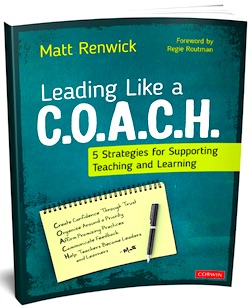Can a Principal Also Be an Instructional Coach?
A prevailing myth in education is that formal school leaders cannot also coach teachers.
I’ve heard this from multiple educators. “How can you be an evaluator and also support teaching and learning?” is a common question. The myth persists because for a long time supervision and evaluation have been a sole responsibility within instructional leadership.
Fortunately, research has debunked this myth. Studies have shown principals can also lead like a coach.
One of my favorite studies comes from the world of Cognitive Coaching. Researchers found that when teachers were coached by another teacher, by an instructional coach, or by an administrator who was trained in coaching, the impact was the same: instruction improved.
This has been my own experience as a principal who has coaching relationships with teachers. In one example, a teacher wasn’t sure whether to focus on classroom management or curriculum as part of her professional practice goal. Through a coaching conversation, she decided on improving her curriculum as a way to mitigate any negative student behaviors.
I don’t think we could have had this authentic and open conversation if I had approached it from a supervisory stance.
Lead like a coach by embedding coaching skills
Three coaching skills – paraphrasing, pausing, and posing questions – are the tools I lean on when collaborating with teachers and other colleagues.
They are simple to use as long as we are mindful about using them. (I sometimes forget and fall back on giving advice or telling teachers what I think they should do.) Once we trust our abilities to embed these skills in our practice, and stay mindful, the results will exceed any expectations we might have for the traditional teacher evaluation system.
Paraphrasing, pausing, posing questions
Here is a brief definition of each skill I used in the example I shared above.
Skill #1: Paraphrasing. It means to put into our own words what the other person said. When the teacher was sharing her possible goals, I organized them verbally and asked her if I was correct in my understanding. (She confirmed that I was.)
Skill #2: Pausing. A moment of silence gives you and the teacher time to process what was said. My teacher appreciated having the opportunity to consider how she might manage both areas of focus for professional learning.
Skill #3: Posing questions. A wondering based on what was previously discussed can empower the teacher to make a decision. In my example, I asked the teacher which priority might address both issues. She opted for improving the curriculum to increase interest and engagement and reduce negative behaviors.
Supervision and evaluation may have its place in schools, but its purpose is not to improve instruction. Leading like a coach, on the other hand, supports teaching and learning. Principals are in prime positions to do this vital work.
Recommended resources on this topic
►Thinking Collaborative (https://www.thinkingcollaborative.com/) is a website with resources for implementing Cognitive Coaching in schools. Check out the short videos of paraphrasing, pausing, and posing questions in the “Resources & More” section.
►Jim Knight wrote this article for Instructional Coaching Group that describes three approaches when coaching professionals: facilitative, dialogical, and directive. My example in this article would be categorized as facilitative.
Matt Renwick is an elementary principal for the Mineral Point Unified School District in Wisconsin. He has served in public education for over 20 years – as a 5th and 6th grade teacher in a country school outside of Wisconsin Rapids; a junior high dean of students; and an assistant principal with athletic director duties.





































